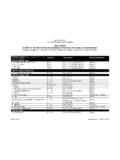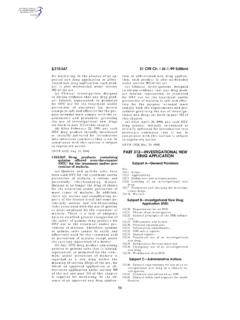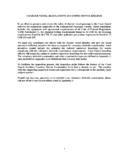Transcription of §142.313 40 CFR Ch. I (7–1–03 Edition)
1 695 Environmental Protection Agency EPA REVIEWANDAPPROVAL OFSMALL SYSTEMVARIANCES What procedures allow the Administrator to object to a pro-posed small system variance or overturn a granted small system variance for a public water system serving 3,300 or fewer persons? (a) At the time a State proposes to grant a small system variance under this subpart, the State must submit to the Administrator the proposed small system variance and all supporting in-formation, including any written pub-lic comments received prior to pro-posal.
2 (b) The Administrator may review and object to any proposed small sys-tem variance within 90 days of receipt of the proposed small system variance. The Administrator must notify the State in writing of each basis for the objection and propose a modification to the small system variance to resolve the concerns of the Administrator. The State must make the recommended modification, respond in writing to each objection, or withdraw the pro-posal to grant the small system vari-ance. (c) If the State issues the small sys-tem variance without resolving the concerns of the Administrator, the Ad-ministrator may overturn the State de-cision to grant the variance if the Ad-ministrator determines that the State decision does not comply with the Act or this rule.
3 What EPA action is necessary when a State proposes to grant a small system variance to a public water system serving a population of more than 3,300 and fewer than 10,000 persons? (a) At the time a State proposes to grant a small system variance to a public water system serving a popu-lation of more than 3,300 and fewer than 10,000 persons, the State must submit the proposed small system vari-ance and all supporting information, including public comments received prior to proposal, to the Adminis-trator.
4 (b) The Administrator must approve or disapprove the small system vari-ance within 90 days of receipt of the proposed small system variance and supporting information. The Adminis-trator must approve the small system variance if it meets each requirement within the Act and this rule. (c) If the Administrator disapproves the small system variance, the Admin-istrator must notify the State in writ-ing of the reasons for disapproval and the small system variance does not be-come effective. The State may resub-mit the small system variance for re-view and approval with modifications to address the objections stated by the Administrator.
5 How will the Administrator review a State s program under this subpart? (a) The Administrator must periodi-cally review each State program under this subpart to determine whether small system variances granted by the State comply with the requirements of the Act, this rule and the affordability criteria developed by the State. (b) If the Administrator determines that small system variances granted by a State are not in compliance with the requirements of the Act, this rule or the affordability criteria developed by the State, the Administrator shall no-tify the State in writing of the defi-ciencies and make public the deter-minations.
6 (c) The Administrator s review will be based in part on quarterly reports prepared by the States pursuant to (a)(1) relating to violations of in-crements of progress or other violated terms or conditions of small system variances. PART 143 NATIONAL SECONDARY DRINKING WATER REGULATIONS Sec. Purpose. Definitions. Secondary maximum contaminant lev-els. Monitoring. AUTHORITY: 42 300f et seq. SOURCE: 44 FR 42198, July 19, 1979, unless otherwise noted. Purpose. This part establishes National Sec-ondary Drinking Water Regulations pursuant to section 1412 of the Safe VerDate Mar<15>2010 07:41 Sep 01, 2011 Jkt 223166 PO 00000 Frm 00705 Fmt 8010 Sfmt 8010 Y:\SGML\ 223166erowe on DSK5 CLS3C1 PROD with CFR696 40 cfr ch .
7 I (7 1 11 Edition) Drinking Water Act, as amended (42 300g 1). These regulations con-trol contaminants in drinking water that primarily affect the aesthetic qualities relating to the public accept-ance of drinking water. At consider-ably higher concentrations of these contaminants, health implications may also exist as well as aesthetic deg-radation. The regulations are not Fed-erally enforceable but are intended as guidelines for the States. Definitions. (a) Act means the Safe Drinking Water Act as amended (42 300f et seq.)
8 (b) Contaminant means any physical, chemical, biological, or radiological substance or matter in water. (c) Public water system means a sys-tem for the provision to the public of piped water for human consumption, if such a system has at least fifteen serv-ice connections or regularly serves an average of at least twenty-five individ-uals daily at least 60 days out of the year. Such term includes (1) any collec-tion, treatment, storage, and distribu-tion facilities under control of the op-erator of such system and used pri-marily in connection with such system, and (2) any collection or pretreatment storage facilities not under such con-trol which are used primarily in con-nection with such system.
9 A public water system is either a community water system or a non-community water system. (d) State means the agency of the State or Tribal government which has jurisdiction over public water systems. During any period when a State does not have responsibi1ity pursuant to section 1443 of the Act, the term State means the Regional Adminis-trator, Environmental Protection Agency. (e) Supplier of water means any person who owns or operates a public water system. (f) Secondary maximum contaminant levels means SMCLs which apply to public water systems and which, in the judgement of the Administrator, are requisite to protect the public welfare.
10 The SMCL means the maximum per-missible level of a contaminant in water which is delivered to the free flowing outlet of the ultimate user of public water system. Contamimants added to the water under cir-cumstances controlled by the user, ex-cept those resulting from corrosion of piping and plumbing caused by water quality, are excluded from this defini-tion. [44 FR 42198, July 19, 1979, as amended at 53 FR 37412, Sept. 26, 1988] Secondary maximum contami-nant levels. The secondary maximum contami-nant levels for public water systems are as follows: Contaminant Level Aluminum.

















